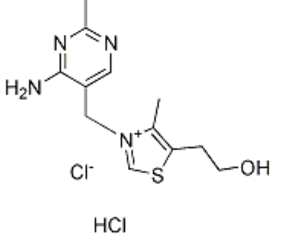
In vitro: Thiamine (50 mM), in addition to its nutritional value, induces systemic acquired resistance (SAR) in rice, tobacco, cucumber, and Arabidopsis. Thiamine-treated rice, Arabidopsis (Arabidopsis thaliana), and vegetable crop plants shows resistance to fungal, bacterial, and viral infections. Thiamine treatment induces the transient expression of pathogenesis-related (PR) genes in rice and other plants. In addition, Thiamine treatment potentiates stronger and more rapid PR gene expression and the up-regulation of protein kinase C activity. Vitamin B1 (10 μM) prevents acetaldehyde-induced inhibition of myocyte shortening in adult rat ventricular myocytes. Vitamin B1 (10 μM) effectively blunts the acetaldehyde-induced depression in ±dL/dt in adult rat ventricular myocytes. Vitamin B1 (10 μM) prevents acetaldehyde-induced shortening of time-to-peak shortening in adult rat ventricular myocytes. Vitamin B1 (10 μM) prevents acetaldehyde-induced elevation in both protein carbonyl formation and caspase-3 activation in adult rat ventricular myocytes. Thiamine uptake is energy- and temperature-dependent, pH-sensitive, Na+-independent, saturable at both the nanomolar (apparent Km, 30 nM) and the micromolar (apparent Km, 1.72 mM) concentration ranges in ARPE-19 cells. Uptake of Thiamine is adaptively regulated by extracellular substrate level via transcriptionally mediated mechanisms that involve both hTHTR-1 and hTHTR-2 in ARPE-19 cells, it is also regulated by an intracellular Ca2+-calmodulin-mediated pathway. Thiamine-responsive megaloblastic anemia (TRMA) fibroblasts are rescued from death with 10 nM-30 nM Thiamine (in the range of normal plasma thiamine concentrations). Normal fibroblasts exhibits saturable, high-affinity thiamine uptake (Km 400 nM-550 nM; Vmax 11 pmol/min/1×106 cells), while TRMA fibroblasts lacks detectable high-affinity uptake. At 30 nM Thiamine, the rate of uptake of Thiamine by TRMA fibroblasts is 10-fold less than that of wild-type, which explains the increased apoptosis of TRMA fibroblasts.
In vivo: Thiamine deficiency results in amyloid precursor protein immunoreactivity accumulated in swollen neurites within, or around lesions in rats, or in abnormal clusters in mice.
| Cell Experiment | |
|---|---|
| Cell lines | HL-60 cells |
| Preparation method | HL-60 cells were pre-treated with 0.25 μg/ml of either cycloheximide or tetrathylammonium, a big potassium channel (BK) blocker, for 2 hours and then cultured for 12 hours with or without thiamine (100 μM) and stained with Giemsa. |
| Concentrations | 100 μM |
| Incubation time | 12 h |
| Animal Experiment | |
|---|---|
| Animal models | |
| Formulation | |
| Dosages | |
| Administration | |
| Molecular Weight | 337.27 |
| Formula | C12H17N4OS.HCl |
| CAS Number | 67-03-8 |
| Solubility (25°C) | 68 mg/mL in water |
| Storage |
Powder -20°C 3 years ; 4°C 2 years In solvent -80°C 6 months ; -20°C 1 month |
| Species | Mouse | Rat | Rabbit | Guinea pig | Hamster | Dog |
| Weight (kg) | 0.02 | 0.15 | 1.8 | 0.4 | 0.08 | 10 |
| Body Surface Area (m2) | 0.007 | 0.025 | 0.15 | 0.05 | 0.02 | 0.5 |
| Km factor | 3 | 6 | 12 | 8 | 5 | 20 |
| Animal A (mg/kg) = Animal B (mg/kg) multiplied by | Animal B Km |
| Animal A Km |
For example, to modify the dose of Compound A used for a mouse (20 mg/kg) to a dose based on the BSA for a rat, multiply 20 mg/kg by the Km factor for a mouse and then divide by the Km factor for a rat. This calculation results in a rat equivalent dose for Compound A of 10 mg/kg.
| Related Vitamin Products |
|---|
| Liarozole
Liarozole (R75251) is an imidazole derivative and orally active retinoic acid (RA) metabolism-blocking agent (RAMBA). Liarozole inhibits the cytochrome P450 (CYP26)-dependent 4-hydroxylation of retinoic acid (IC50=7 μM). |
| VDR agonist 2
VDR agonist 2 is a VDR (vitamin D receptor) agonist that can effectively inhibit TGF-β1-induced activation of hepatic stellate cells (HSC). |
| Atocalcitol
Atocalcitol, a vitamin D3 analogue, is used in the study for psoriasis. |
| Elocalcitol
Elocalcitol (BXL-628) is a selective, orally active vitamin D receptor (VDR) agonist. Elocalcitol shows anti-inflammatory activity. Elocalcitol inhibits growth of prostate cancer cells. |
| ZK168281
ZK168281 is a 25-carboxylic ester 1α,25(OH)2D3 analog and a pure VDR antagonist with a Kd value of 0.1 nM. ZK168281 is an effective inhibitor of the coactivator (CoA) interaction of its receptor. |


Products are for research use only. Not for human use. We do not sell to patients.
© Copyright 2010-2023 AbMole BioScience. All Rights Reserved.
